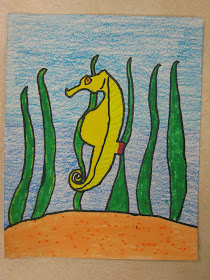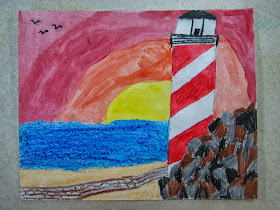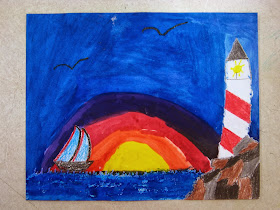While showing J. J. Audubon's blue heron, I asked my students what kind of habitat the heron may live in. In most classes, the first answer was by the water! There is just a little bit of water in the bottom left and bottom right of the painting, but my students generally found it quite quickly. Then, I asked my students if any of them had seen a blue heron before. The ones that had shared where. By grandpa's lake, by the river on a canoe trip, by the creek behind the farm, and by the pond were common answers. J. J. Audubon's painting does show us the blue heron's habitat, but it doesn't show us exactly what kind of water the bird is by. I suggested to the students that perhaps the artist didn't want to be specific about what kind of water, since blue herons can be found by lakes, creeks, streams, ponds, and other bodies of water.
Then, we discussed Audubon's aesthetic choices in putting the environment he did in the painting. Then, I suggested other animals, and asked what kind of environment would be realistic and make a nice picture. For example, a butterfly could be fluttering across the sky, hovering over flowers, or sitting on a leaf. All of those ideas work, but as an artist, which one is the most aesthetic choice? We had some discussion about different animals' habitats.
Then, the students chose an animal to draw, and chose an environment to put it in. They could use markers or crayons for this. I had about 40 different animal photographs the students could draw from. Many of the photographs had bland backgrounds (i.e. a toucan sitting on a brown branch with a brown background), but the students knew the photograph was just for reference, and they were to create their own beautiful environment for the animal.
If the students wanted to draw an animal that I didn't have a photo of, I sometimes printed it for them from the internet, but I also told some students to draw from their imagination if they knew the animal very well.
This lesson was done with grades 3, 4, and 5. The main purpose was to create artwork for Art to Remember, a fundraiser I mentioned a few posts ago. The lesson was very successful over all, and most students created something they were proud of that was beautiful. Most children like animals, and have a favorite animal, so the students' level of interest was pretty high.
Monday, September 30, 2013
Thursday, September 26, 2013
4th and 5th Grade Lighthouses
My 4th and 5th grade students have been working on lighthouse art. They drew the lighthouse, land, and water with crayons, and then used a choice of watercolors or watercolor pencils for the sky. Some students also used a light watercolor wash over their ocean to fill in white spots. I didn't work as much art history into this lesson as I would have liked (anyone know of a famous artist who painted lighthouses?), but we hit a lot of elements and principles of art on this project!



























































